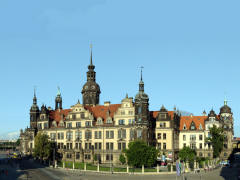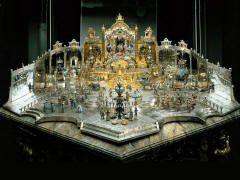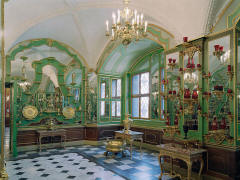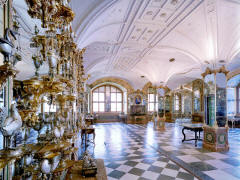|
Page 1 2 3 4 5 6 7 8 9 10 11 12 Dresden
Thursday, 3
October. We were up at 7:00. Today was our
60th wedding anniversary. It was also a public holiday, the Day of
German Unity, celebrating the reunification of Germany
in 1990. We thought it was very nice of the Germans to
make our anniversary a holiday. At 8:30 we went to a
shipboard lecture featuring local residents comparing
their lives before and after reunification. However, all
of them were from families that had independent
businesses during that time, so there experiences were
not typical. At 9:30 our group left on a two-hour walking tour of old Dresden. Really though, what we saw was not old at all. Dresden has a long history (since 1356) as the capital and royal residence of the Electors and Kings of Saxony, who for centuries lavished the city with cultural and artistic projects. The city was long recognized as a leading European center of art, classical music, culture, science, and architecture. Then in February 1945 the center of Dresden (15 square miles) was utterly destroyed in a series of air raids. There has since been much controversy over the justification for such a drastic action when the Germans were already defeated at the time. Under early Russian occupation, much of the rubble was cleared, cleaned and preserved using unpaid volunteer workers, almost entirely women and children since few men were left in the city. Later, when the German Democratic Republic (GDR) began reconstruction, the original stones were used to the maximum extent possible. The GDR rebuilt many important historic buildings (e.g., Semper Opera House (1985), the Zwinger Palace (1951-64)). However, the ruins of some churches, royal buildings and palaces were razed instead of being repaired, and large areas of the city were rebuilt in the soviet realist style. Reconstruction has continued since reunification. Most notably, the Frauenkirche was carefully restored over seven years (1998-2005), again using many of the original stones. Our walking tour took us about half a mile along the Elbe to the Neumarkt (New Market), site of the Frauenkirche (Church of Our Lady). The original Catholic church here was built in the 11th century. That church was torn down in 1727 and replaced by a larger Lutheran church in 1743. That was the church destroyed in 1945 and just reopened in 2005. Also on Neumarkt we saw the reconstruction (1960) of the 16th century Royal Mews (stables). In 1876 the building was remodeled and renamed the Johanneum, the name is now bears. Today it houses the Dresden Transport Museum.
Our guide
led us out of the Neumarkt on Augustus Street past the
Procession of Princes (Fuerstenzug), a large mural on
the outer wall of a Dresden Castle courtyard. It depicts
a mounted procession of the rulers of Saxony from 1127
to 1904. It was originally a painting (1876) that
rapidly deteriorated in the weather. It was replaced
with about 23,000 Meissen porcelain tiles (1904-1907).
The tiles sustained only minimal damage in the 1945
bombing of Dresden.
We continued on past the Castle and the Catholic Cathedral of the Holy Trinity (1751, restored in the 1980s) and crossed over to Theater Platz, site of the Semperoper opera house (1878, reconstructed 1985). Major works by Richard Wagner and Richard Strauss had their premiere here. Also on Theater Platz is one wing of the Zwinger Palace housing the Old Masters Gallery. The Zwinger Palace (1710-1732) is said to be Dresden's most famous landmark. Jutta led us next to the Palace's central courtyard. The rectangular courtyard is enclosed on three sides by large galleries interrupted by the Crown Gate and six pavilions, most notably the Rampart Pavilion and Carillon Pavilion. (The Old Masters Gallery fills the fourth side.) Destroyed in the 1945 air raids, reconstruction was begun by the Soviet Union that same year, but it was 1961 before it was mostly completed. Our group left the Zwinger about 11:00 and walked over to the Royal Palace. Like other Dresden landmarks, the Palace was largely destroyed in 1945. Major reconstruction finally started in 1985 and was mostly completed in 2006 (the city's 800th anniversary). Some of the original interior has been restored, but not all. However, the unique collections of the elector Frederic Augustus I (Augustus the Strong) have been preserved and are displayed in a complex of museums. As the group dispersed, Jutta gave us tickets that included all the Palace's museums, but the tickets for the historic Green Vault were for a specific time to prevent overcrowding. Our tickets were for 3:00, so we decided to wait until we came back to see some of the other museums, too. On our way back to the ship, we explored Neumarkt more thoroughly. We saw that reconstruction is continuing, with another major building slated for rebuilding in what is now a big hole. We also went into the Frauenkirche to see the interior. We wandered through Bruhl's Park and Terrace before finding our way to the street along the river and back to our ship. We went onboard just at noon. We found a bottle of champagne in our room with a note from the crew wishing us a happy anniversary. On our way to lunch at 12:30, we dropped the bottle off at the bar to be chilled for dinner. At 2:00 we took the GCT shuttle bus back to the Royal Palace. That gave us time to see some of the other museums before going to the historical Green Vault for our 3:00 appointment. The Green Vault is foremost among the Palace museums. In fact, there are two distinct Green Vaults. The historic Green Vault as a private treasure chamber dates back to 1547. But in 1773 Augustus the Strong refurbished and enlarged that vault into a magnificent public museum, adding many of his crown treasures. Severely damaged in the 1945 bombing, the historic Green Vault, restored to its 1773 splendor, reopened in 2006. It includes the entire original collection of about 3,000 pieces, including bronze statues and works of art in silver, gold, amber and ivory. In addition, during the restoration of the Palace, a New Green Vault was added (2004) to display another 1,100 items, mostly from the 16th and 17th centuries.
Upon our arrival at the Palace, we started with the Armory. It
houses a fabulous collection of parade and tournament
weapons, firearms, and racing and jousting equipment,
all from the 15th to the 18th century. Even more
interesting was the Turkish Chamber, a separate
collection within the Armory. One of the oldest and most
significant collections of Ottoman art, it features
diplomatic gifts, purchased objects, weapons and other
booty captured in various battles against the Ottomans
over the course of centuries. A huge (66 by 26 feet)
field tent partly made with gold and silk was the most
spectacular item.
Next we went through the New
Green Vault. It was amazing what extraordinarily fine
and elaborate works the smiths and jewelers could
produce. It was even more amazing that they found
patrons to buy such extravagant works. Perhaps the most
extreme example was a model of a Grand Mogul of India
celebrating his birthday. It took a group of master gold
and silversmiths seven years (1701-1708) to fashion it.
Besides the gold and silver, it contains 4,909 diamonds,
160 rubies, 164 emeralds, 16 pearls, two cameos, and a
sapphire.
Then it was 3:00, the appointed time for us to see the Historic Green Vault, so we had to leave the New Green Vault. The most obvious difference from the other collections we’d seen was that in the historic Green Vault the baroque rooms themselves were works of art. The vault consists of an entrance chamber and nine rooms. The treasures were generally arranged either by the material from whih they are made (e.g., amber, ivory, silver) or by theme (e.g., vessels, coats of arms). The beauty of the rooms, the luxury of the materials, and the exquisite artistry combine to make this a truly memorable experience. After seeing the historic Green Vault, we returned to the New Green Vault to finish seeing that. We also took a quick walk through Coin Collection (Muenzkabinett), but we had already seen so much that we were close to sensory overload.
We caught the 4:45 shuttle back to the
ship. We rested until the port talk at 6:45. Dinner at
7:00 was a German buffet. Perhaps because of that, the
waiters did not do the birthday/anniversary parade and
song they had been doing regularly for other passengers
on previous nights. We were disappointed, but we were
sitting with good friends we had met on the trip and had
a pleasant evening. We came to the lounge at 9:15 for a
magic show, but it was so bad that we had to leave.
Copyright © 2000-2023 DarrellPeck.com All rights
reserved. | ||||||||








